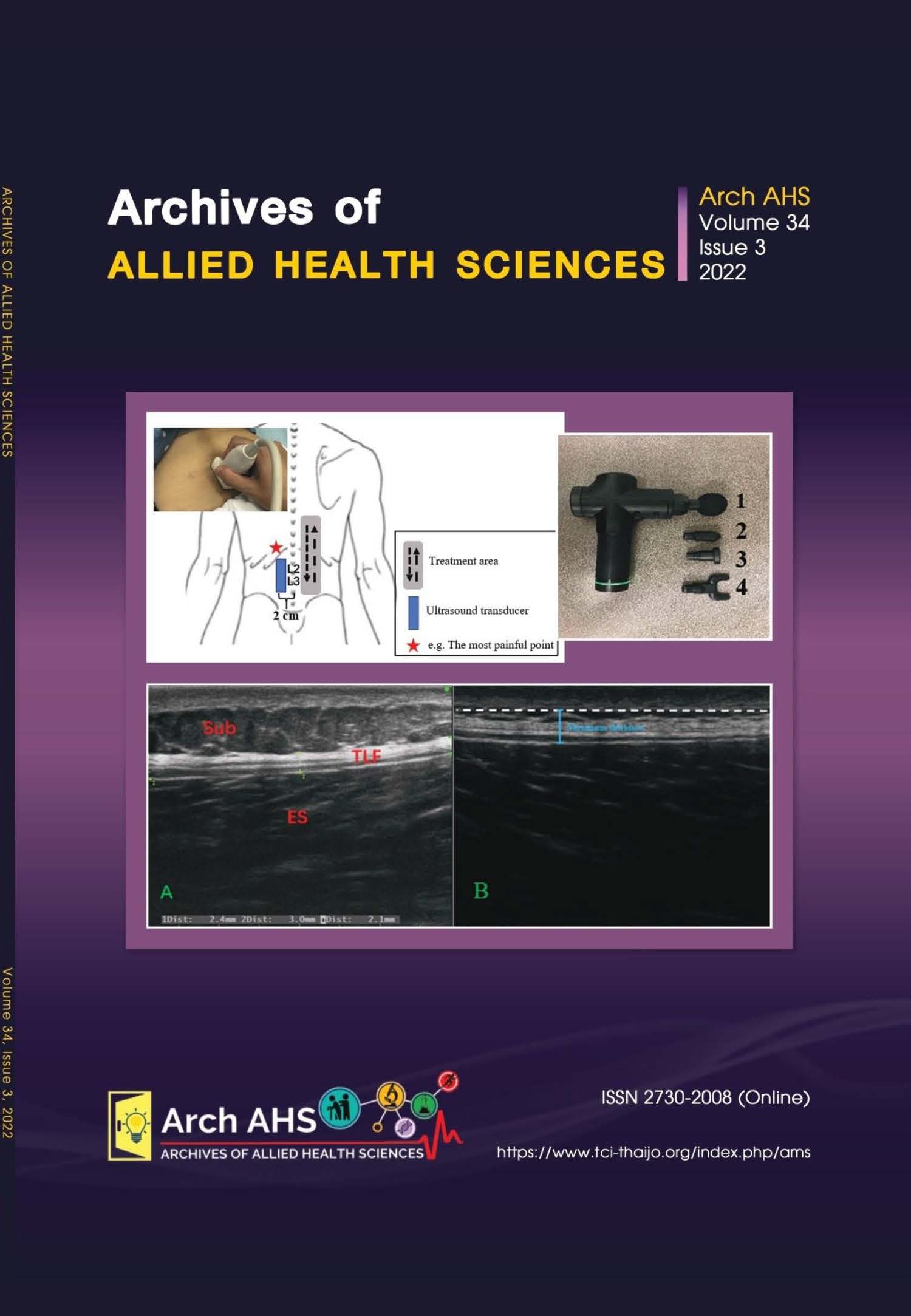Diagnostic performance of immunochromatographic assay and fluorescence immunoassay for the detection of acute dengue infection
Main Article Content
Abstract
Dengue is a crucial public health issue worldwide. The clinical manifestation of dengue infection is nonspecific. The high performance of the dengue diagnostic test has led to prompt and well-organised treatment. To detect dengue infection in routine laboratories, the immunochromatographic rapid test is generally used. Nowadays, highperformance commercial kits are distributed by many manufacturers. A new rapid fluorescent immunoassay (FIA) for the detection of acute dengue infection was declared to reduce technical errors (naked-eye detection) and produced high sensitivity and specificity. Herein, we evaluated two features of the acute dengue infection test kit, including an immunochromatographic assay (ICT) and new rapid fluorescence immune assay (FIA) compared to retrieved clinical data. Twenty plasma samples were tested for dengue NS1 Ag and dengue IgM/IgG by ICT and FIA against clinical data. The results showed a higher sensitivity of FIA compared to ICT (81.8% and 72.7%). In contrast, the specificity of ICT was greater than FIA (66.7% and 44.4%). Moreover, ICT provided 72.7% PPV and 66.7% NPV, while IFA provided 64.2% PPV and 66.7% NPV. However, the performance of commercial test kits may be dependent on dengue serotypes, the day of onset, the manufacturer, and the tested sample size. Due to limited resources, only twenty samples were included in this study. For more precise information, the sample size should be increased. Nevertheless, this study provided sufficient fundamental efficacy information on the test kits for purchasing decisions.
Article Details

This work is licensed under a Creative Commons Attribution-NonCommercial-NoDerivatives 4.0 International License.
References
Halstead SB. Pathogenesis of dengue: challenges to molecular biology. Science 1988; 239(4839): 476-81.
Kurane I. Dengue hemorrhagic fever with special emphasis on immunopathogenesis. Comp Immunol Microbiol Infect Dis 2007; 30(5-6): 329-40.
Sri Rezeki S. Hadinegoro. The revised WHO dengue case classification: does the system need to be modified? Paediatr Int Child Health 2012; 32(1): 33-8.
Srikiatkhachorn A, Rothman AL, Gibbons RV, Sittisombut N, Malasit P, Ennis FA, et al. Dengue-how best to classify it. Clin Infect Dis 2011; 53(6): 563-7.
Brady OJ, Gething PW, Bhatt S, Messina JP, Brownstein JS, Hoen AG, et al. Refining the global spatial limits of dengue virus transmission by evidence-based consensus. PLoS Negl Trop Dis 2012; 6(8): 1-15.
Department of disease control, Ministry of public health Thailand. Dengue fever report [online] 2020 [cited 2021 Sep 25]. Available from: http://phanhospital.go.th/phanhospital/images/Disease20situation/DHF_Wk18 2004282563.pdf
Hasan Khan MI, Anwar E, Agha A, Saleh N, Ullah E, Syed IA, et al. Factors predicting morbidity in patients with dengue fever in a tertiary care hospital. Mediterr J Hematol Infect Dis 2013; 5(1): 1-6.
Soo KM, Khalid B, Ching SM, Chee HY. Meta-analysis of dengue severity during infection by different dengue virus serotypes in primary and secondary infections. PLOS ONE 2016; 11(5): 1-16.
Lee H, Ryu JH, Park H-S, Park KH, Bae H, Yun S, et al. Comparison of six commercial diagnostic tests for the detection of dengue virus non-structural-1 antigen and IgM/IgG antibodies. Ann Lab Med 2019; 39(6): 566-71.
Muller DA, Young PR. The flavivirus NS1 protein: Molecular and structural biology, immunology, role in pathogenesis and application as a diagnostic biomarker. Antiviral Res 2013; 98(2): 192-208.
Fan J, Liu Y, Yuan Z. Critical role of Dengue Virus NS1 protein in viral replication. Virol Sin 2014; 29(3): 162-9.
Darwish NT, Sekaran SD, Khor SM. Pointof-care tests: a review of advances in the emerging diagnostic tools for dengue virus infection. Sens Actuators B Chem 2018; 255(3): 3316-31.
Linares EM, Pannuti CS, Kubota LT, Thalhammer S. Immunospot assay based on fluorescent nanoparticles for Dengue fever detection. Biosens Bioelectron 2012; 41(2013): 180-5.
Zammarchi L, Colao MG, Mantella A, Capobianco T, Mazzarelli G, Ciccone N, et al. Evaluation of a new rapid fluorescence immunoassay for the diagnosis of dengue and Zika virus infection. J Clin Virol 2019; 112: 34-9.
Jang WS, Kwak SY, May WL, Yang DJ, Nam J, Lim CS. Comparative evaluation of three dengue duo rapid test kits to detect NS1, IgM, and IgG associated with acute dengue in children in Myanmar. PLOS ONE 2019; 14(3): e0213451.
Prado PS, Almeida JT, Abreu LT, Silva CG, Souza LD, Gomes MC, et al. Validation and reliability of the rapid diagnostic test ‘SD Bioeasy Dengue Duo’for dengue diagnosis in Brazil: a phase III study. Memórias do Instituto Oswaldo Cruz 2018; 113(8): 1-8.
Yow KS, Aik J, Tan EYM, Ng LC, Lai YL. Rapid diagnostic tests for the detection of recent dengue infections: an evaluation of six kits on clinical specimens. PLOS ONE 2021; 16(4): 1-11.
Martins TB, Pasi BM, Litwin CM, Hill HR. Heterophile antibody interference in a multiplexed fluorescent microsphere immunoassay for quantitation of cytokines in human serum. Clin Vaccine Immunol 2004; 11(2): 325-9.
Gaće M, Špacir Prskalo Z, Dobrijević S, Mayer L. Most common interferences in immunoassays. Croat J Oncol 2015; 43(1-3): 23-7.
DiMagno EP, Corle D, O’Brien JF, Masnyk IJ, Go VL, Aamodt R. Effect of long-term freezer storage, thawing, and refreezing on selected constituents of serum. Mayo Clin Proc 1989; 64(10): 1226-34.
Torelli A, Gianchecchi E, Monti M, Piu P, Barneschi I, Bonifazi C, et al. Effect of Repeated Freeze–Thaw Cycles on Influenza Virus Antibodies. Vaccines (Basel) 2021; 9(3): 267-6.
Shurrab FM, Al-Sadeq DW, Amanullah F, Younes SN, Al- Jighefee H, Younes N, et al. Effect of multiple freeze-thaw cycles on detection of anti-SARS-CoV-2 IgG antibodies. medRxiv. J Med Microbiol 2021; 70(8): 1-4.


